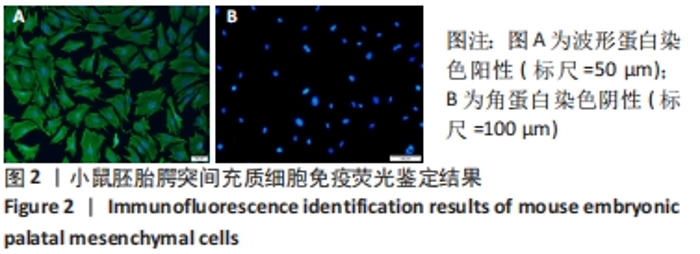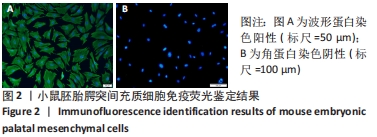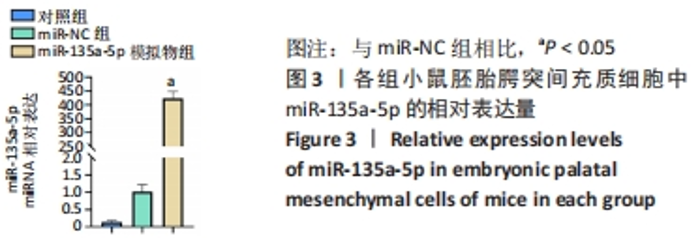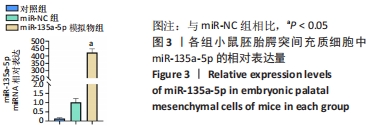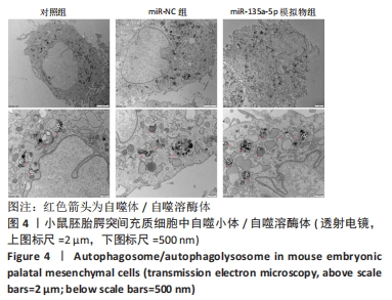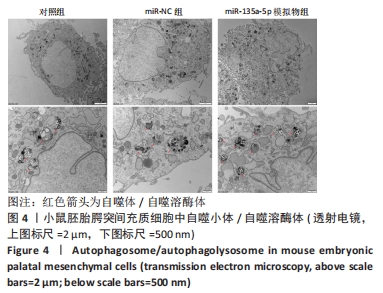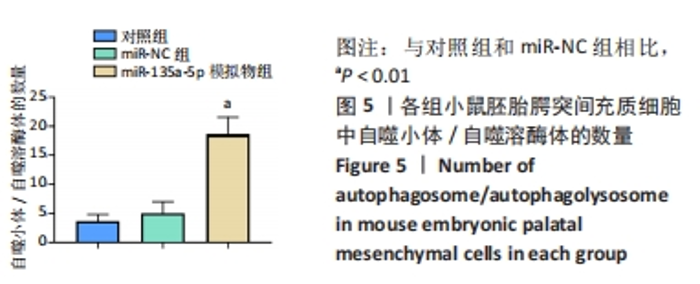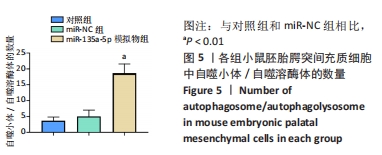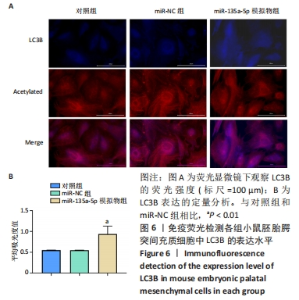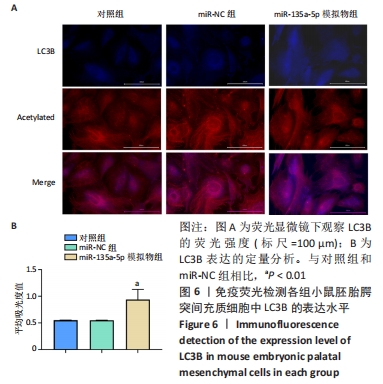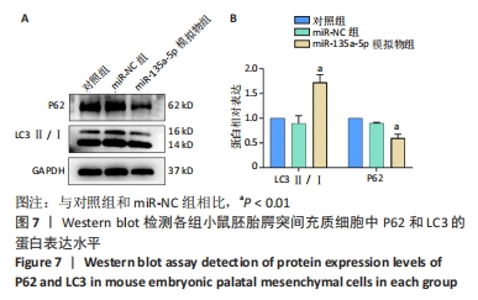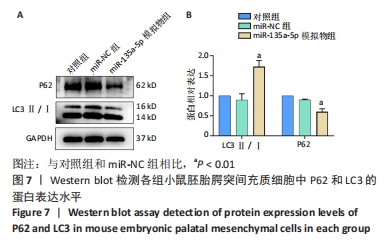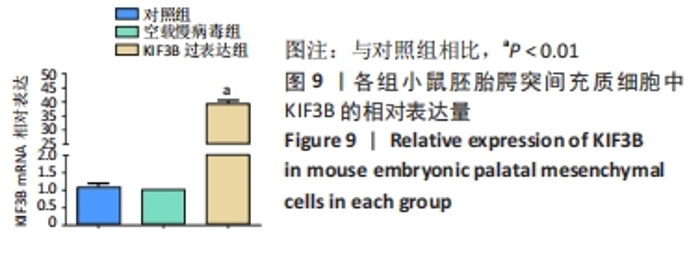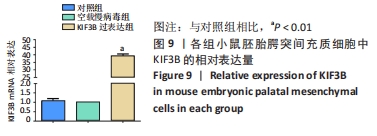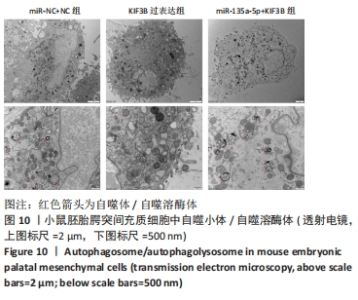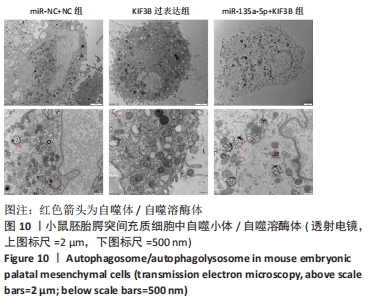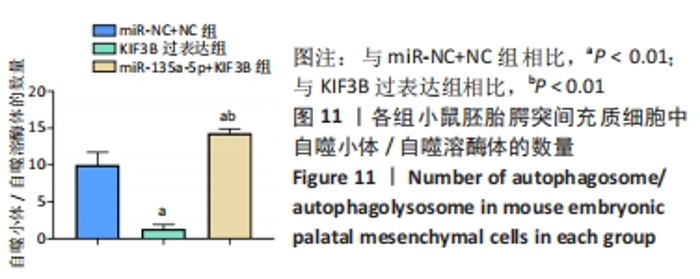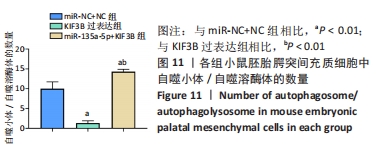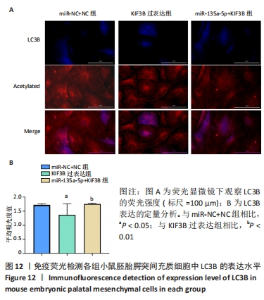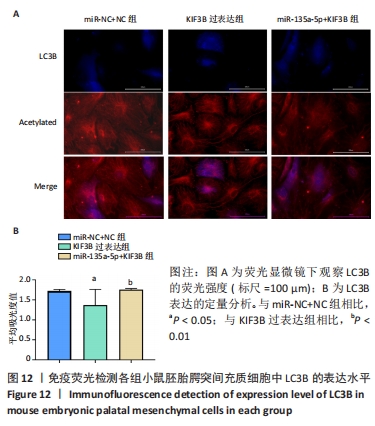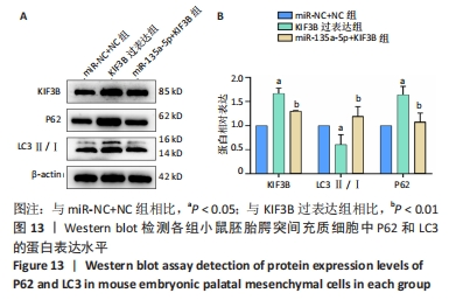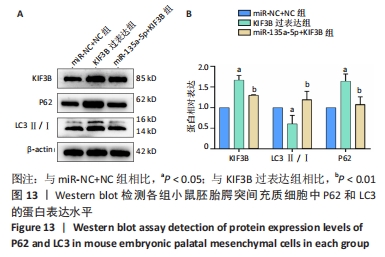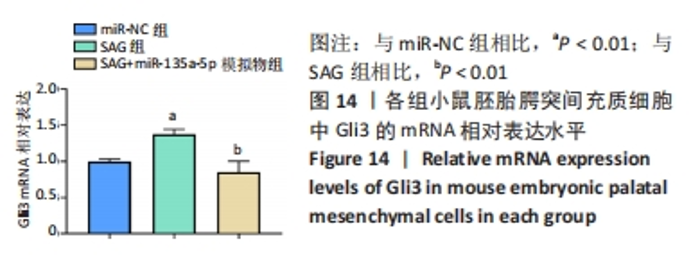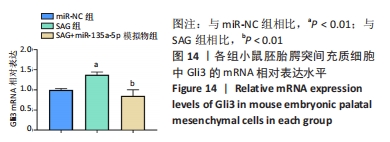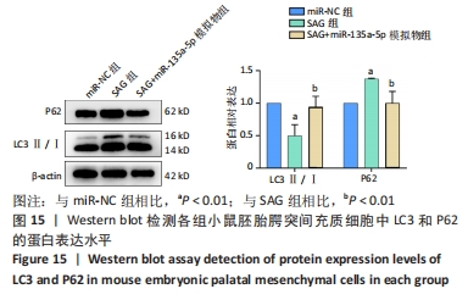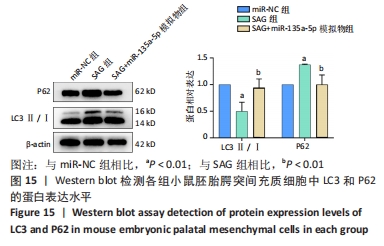Chinese Journal of Tissue Engineering Research ›› 2024, Vol. 28 ›› Issue (19): 3003-3011.doi: 10.12307/2024.151
Previous Articles Next Articles
miR-135a-5p regulates autophagy of mouse embryonic palatal mesenchymal cells via targeting Kif3B
Feng Wenxuan1, Lian Shubo1, Wang Zhe1, Chen Jing1, He Wei1, 2
- 1School of Stomatology, Zunyi Medical University, Zunyi 563000, Guizhou Province, China; 2Hospital of Stomatology, Zunyi Medical University, Zunyi 563000, Guizhou Province, China
-
Received:2023-04-15Accepted:2023-05-15Online:2024-07-08Published:2023-09-26 -
Contact:He Wei, MD, Associate professor, School of Stomatology, Zunyi Medical University, Zunyi 563000, Guizhou Province, China; Hospital of Stomatology, Zunyi Medical University, Zunyi 563000, Guizhou Province, China -
About author:Feng Wenxuan, Master candidate, School of Stomatology, Zunyi Medical University, Zunyi 563000, Guizhou Province, China -
Supported by:National Natural Science Foundation of China, No. 82160176 (to HW); Postgraduate Research Fund Project of Zunyi Medical University, No. ZYK65 (to FWX)
CLC Number:
Cite this article
Feng Wenxuan, Lian Shubo, Wang Zhe, Chen Jing, He Wei. miR-135a-5p regulates autophagy of mouse embryonic palatal mesenchymal cells via targeting Kif3B[J]. Chinese Journal of Tissue Engineering Research, 2024, 28(19): 3003-3011.
share this article
Add to citation manager EndNote|Reference Manager|ProCite|BibTeX|RefWorks
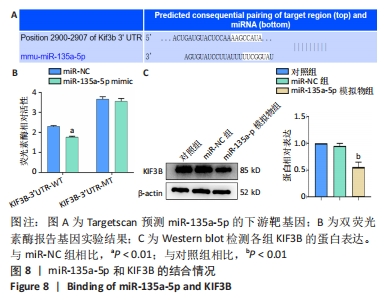
2.4 miR-135a-5p可直接结合KIF3B,靶向调控KIF3B的表达 运用 Targetscan预测miR-135a-5p的下游靶基因,即KIF3B。双荧光素酶结果显示,共转染 KIF3B-3′UTR-WT时,与miR-135a-5p阴性对照组相比,miR-135a-5p模拟物组能减弱荧光素酶活性(P < 0.01);而共转染KIF3B-3′UTR-MT 时,两组荧光素酶活性差异无显著性意义(P > 0.05);Western blot结果显示,与对照组相比,miR-135a-5p阴性对照组KIF3B的表达差异无显著性意义(P > 0.05);与miR-135a-5p阴性对照组相比,miR-135a-5p模拟物组KIF3B的表达降低(P < 0.01),表明miR-135a-5p可靶向调控KIF3B的表达,见图8。"
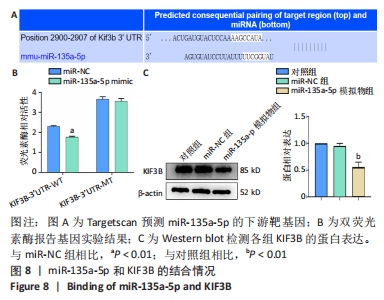
| [1] MARTINELLI M, PALMIERI A, CARINCI F, et al. Non-syndromic Cleft Palate: An Overview on Human Genetic and Environmental Risk Factors. Front Cell Dev Biol. 2020;8:592271. [2] MOSSEY PA, LITTLE J, MUNGER RG, et al. Cleft lip and palate. Lancet. 2009; 374(9703):1773-1785. [3] DIXON MJ, MARAZITA ML, BEATY TH, et al. Cleft lip and palate: understanding genetic and environmental influences. Nat Rev Genet. 2011; 12(3):167-178. [4] GRITLI-LINDE A. The etiopathogenesis of cleft lip and cleft palate: usefulness and caveats of mouse models. Curr Top Dev Biol. 2008;84:37-138. [5] JURILOFF DM, HARRIS MJ, MAGER DL, et al. Epigenetic mechanism causes Wnt9b deficiency and nonsyndromic cleft lip and palate in the A/WySn mouse strain. Birth Defects Res A Clin Mol Teratol. 2014;100(10):772-788. [6] ZHANG Y, DONG S, WANG J, et al. Involvement of Notch2 in all‑trans retinoic acid‑induced inhibition of mouse embryonic palate mesenchymal cell proliferation. Mol Med Rep. 2017;16(3):2538-2546. [7] ZHANG H, LIU X, GAO Z, et al. Excessive retinoic acid inhibit mouse embryonic palate mesenchymal cell growth through involvement of Smad signaling. Anim Cells Syst (Seoul). 2016;21(1):31-36. [8] HAMMOND NL, BROOKES KJ, DIXON MJ. Ectopic Hedgehog Signaling Causes Cleft Palate and Defective Osteogenesis. J Dent Res. 2018;97(13):1485-1493. [9] HE W, MENG T, WU M, et al. Perturbation of Fgf10 signal pathway in mouse embryonic palate by dexamethasone and vitamin B12 in vivo. J Pediatr Surg. 2010;45(10):2030-2035. [10] MIRVIS M, STEARNS T, JAMES NELSON W. Cilium structure, assembly, and disassembly regulated by the cytoskeleton. Biochem J. 2018;475(14):2329-2353. [11] PREVO B, SCHOLEY JM, PETERMAN EJG. Intraflagellar transport: mechanisms of motor action, cooperation, and cargo delivery. FEBS J. 2017;284(18): 2905-2931. [12] CHANDRA B, TUNG ML, HSU Y, et al. Retinal ciliopathies through the lens of Bardet-Biedl Syndrome: Past, present and future. Prog Retin Eye Res. 2022;89:101035. [13] KONG JH, SIEBOLD C, ROHATGI R. Biochemical mechanisms of vertebrate hedgehog signaling. Development. 2019;146(10): dev166892. [14] 殷杰,郭阁,王明雪,等.小鼠胚胎腭间充质细胞的初级纤毛观察[J].武汉大学学报(医学版),2018,39(4):587-590,609. [15] 郭佳男. IFT122通过初级纤毛介导的Shh信号通路调控mEPMCs增殖的机制研究[D].遵义:遵义医科大学,2020. [16] SERMERSHEIM MA, PARK KH, GUMPPER K, et al. MicroRNA regulation of autophagy in cardiovascular disease. Front Biosci (Landmark Ed). 2017; 22(1):48-65. [17] PAMPLIEGA O, ORHON I, PATEL B, et al. Functional interaction between autophagy and ciliogenesis. Nature. 2013;502(7470):194-200. [18] ORHON I, DUPONT N, PAMPLIEGA O, et al. Autophagy and regulation of cilia function and assembly. Cell Death Differ. 2015;22(3):389-397. [19] LOU S, MA L, KAN S, et al. Association Study of Genetic Variants in Autophagy Pathway and Risk of Non-syndromic Cleft Lip With or Without Cleft Palate. Front Cell Dev Biol. 2020;8:576. [20] MENS MMJ, GHANBARI M. Cell Cycle Regulation of Stem Cells by MicroRNAs. Stem Cell Rev Rep. 2018;14(3):309-322. [21] TANG J, LIAN SB, BAI Y, et al. Comprehensive analysis of plasma miRNA and related ceRNA network in non-syndromic cleft lip and/or palate. Int J Pediatr Otorhinolaryngol. 2022;162:111306. [22] DING HL, HOOPER JE, BATZEL P, et al. MicroRNA Profiling during Craniofacial Development: Potential Roles for Mir23b and Mir133b. Front Physiol. 2016;7:281. [23] YOSHIOKA H, SUZUKI A, IWAYA C, et al. Suppression of microRNA 124-3p and microRNA 340-5p ameliorates retinoic acid-induced cleft palate in mice. Development. 2022;149(9):dev200476. [24] LIU H, PU L, TSAUO C, et al. A new congenital cleft palate New Zealand rabbit model for surgical research. Sci Rep. 2021;11(1):3865. [25] FUNABASHI T, KATOH Y, OKAZAKI M, et al. Interaction of heterotrimeric kinesin-II with IFT-B-connecting tetramer is crucial for ciliogenesis. J Cell Biol. 2018;217(8):2867-2876. [26] LANG Z, FAN X, LIN H, et al. Silencing of SNHG6 alleviates hypoxia/reoxygenation-induced cardiomyocyte apoptosis by modulating miR-135a-5p/HIF1AN to activate Shh/Gli1 signalling pathway. J Pharm Pharmacol. 2021;73(1):22-31. [27] MOSSEY PA, MODELL B. Epidemiology of oral clefts 2012: an international perspective. Front Oral Biol. 2012;16:1-18. [28] KHANDELWAL KD, VAN BOKHOVEN H, ROSCIOLI T, et al. Genomic approaches for studying craniofacial disorders. Am J Med Genet C Semin Med Genet. 2013;163C(4):218-231. [29] GAO LY, ZHANG FQ, ZHAO WH, et al. LncRNA H19 and Target Gene-mediated Cleft Palate Induced by TCDD. Biomed Environ Sci. 2017;30(9):676-680. [30] HE Z, LIU X, LIU X, et al. The role of MEG3 in the proliferation of palatal mesenchymal cells is related to the TGFβ/Smad pathway in TCDD inducing cleft palate. Toxicol Appl Pharmacol. 2021;419:115517. [31] RADHAKRISHNA U. Small players with a big role: MicroRNAs in pathophysiology of cleft lip and palate. Indian J Hum Genet. 2012;18(3): 272-273. [32] SHI L, LI B, ZHANG B, et al. Mouse embryonic palatal mesenchymal cells maintain stemness through the PTEN-Akt-mTOR autophagic pathway. Stem Cell Res Ther. 2019;10(1):217. [33] 瞿功玲. Shh信号通路变化对小鼠胚胎腭突间充质细胞自噬的影响[D].遵义:遵义医科大学,2021. [34] KO JY, LEE EJ, PARK JH. Interplay Between Primary Cilia and Autophagy and Its Controversial Roles in Cancer. Biomol Ther (Seoul). 2019;27(4):337-341. [35] CHAKRABORTY J, CAICCI F, ROY M, et al. Investigating mitochondrial autophagy by routine transmission electron microscopy: Seeing is believing? Pharmacol Res. 2020;160:105097. [36] DIKIC I, ELAZAR Z. Mechanism and medical implications of mammalian autophagy. Nat Rev Mol Cell Biol. 2018;19(6):349-364. [37] QIN Y, HUANG J, ZHAO X, et al. MiR-135a-5p and Mst1 regulate MPP + -1 induced apoptosis and autophagy in Parkinson’s disease model in vitro. Cell Signal. 2022;94:110328. [38] CHEN JY, XU LF, HU HL, et al. MiRNA-215-5p alleviates the metastasis of prostate cancer by targeting PGK1. Eur Rev Med Pharmacol Sci. 2020; 24(2):639-646. [39] COGNÉ B, LATYPOVA X, SENARATNE LDS, et al. Mutations in the Kinesin-2 Motor KIF3B Cause an Autosomal-Dominant Ciliopathy. Am J Hum Genet. 2020;106(6):893-904. [40] YUAN G, SINGH G, CHEN S, et al. Cleft Palate and Aglossia Result From Perturbations in Wnt and Hedgehog Signaling. Cleft Palate Craniofac J. 2017;54(3):269-280. [41] SHIN JO, SONG J, CHOI HS, et al. Activation of sonic hedgehog signaling by a Smoothened agonist restores congenital defects in mouse models of endocrine-cerebro-osteodysplasia syndrome. EBioMedicine. 2019;49: 305-317. [42] ABRAMYAN J. Hedgehog Signaling and Embryonic Craniofacial Disorders. J Dev Biol. 2019;7(2):9. [43] WANG Q, KUROSAKA H, KIKUCHI M, et al. Perturbed development of cranial neural crest cells in association with reduced sonic hedgehog signaling underlies the pathogenesis of retinoic-acid-induced cleft palate. Dis Model Mech. 2019;12(10):dmm040279. [44] HUANGFU D, LIU A, RAKEMAN AS, et al. Hedgehog signalling in the mouse requires intraflagellar transport proteins. Nature. 2003;426(6962):83-87. [45] JIMENEZ-SANCHEZ M, MENZIES FM, CHANG YY, et al. The Hedgehog signalling pathway regulates autophagy. Nat Commun. 2012;3:1200. [46] WEI C, PAN Y, ZHANG Y, et al. Overactivated sonic hedgehog signaling aggravates intrauterine adhesion via inhibiting autophagy in endometrial stromal cells. Cell Death Dis. 2020;11(9):755. [47] XIAO Q, YANG Y, QIN Y, et al. AMP-activated protein kinase-dependent autophagy mediated the protective effect of sonic hedgehog pathway on oxygen glucose deprivation-induced injury of cardiomyocytes. Biochem Biophys Res Commun. 2015;457(3):419-425. [48] PIETROBONO S, GAGLIARDI S, STECCA B. Non-canonical Hedgehog Signaling Pathway in Cancer: Activation of GLI Transcription Factors Beyond Smoothened. Front Genet. 2019;10:556. [49] YU JS, CUI W. Proliferation, survival and metabolism: the role of PI3K/AKT/mTOR signalling in pluripotency and cell fate determination. Development. 2016;143(17):3050-3060. [50] PAQUETTE M, EL-HOUJEIRI L, PAUSE A. mTOR Pathways in Cancer and Autophagy. Cancers (Basel). 2018;10(1):18. [51] MANNING BD, TEE AR, LOGSDON MN, et al. Identification of the tuberous sclerosis complex-2 tumor suppressor gene product tuberin as a target of the phosphoinositide 3-kinase/akt pathway. Mol Cell. 2002;10(1):151-162. [52] LONG X, LIN Y, ORTIZ-VEGA S, et al. Rheb binds and regulates the mTOR kinase. Curr Biol. 2005;15(8):702-713. [53] DOBRENEL T, CALDANA C, HANSON J, et al. TOR Signaling and Nutrient Sensing. Annu Rev Plant Biol. 2016;67:261-285. [54] BOND P. Regulation of mTORC1 by growth factors, energy status, amino acids and mechanical stimuli at a glance. J Int Soc Sports Nutr. 2016;13:8. [55] HE D, WU H, XIANG J, et al. Gut stem cell aging is driven by mTORC1 via a p38 MAPK-p53 pathway. Nat Commun. 2020;11(1):37. [56] HE C, KLIONSKY DJ. Regulation mechanisms and signaling pathways of autophagy. Annu Rev Genet. 2009;43:67-93. |
| [1] | Wang Ji, Zhang Min, Li Wenbo, Yang Zhongya, Zhang Long. Effect of aerobic exercise on glycolipid metabolism, skeletal muscle inflammation and autophagy in type 2 diabetic rats [J]. Chinese Journal of Tissue Engineering Research, 2024, 28(8): 1200-1205. |
| [2] | Zhou Bangyu, Li Jie, Ruan Yushang, Geng Funeng, Li Shaobo. Effects of Periplaneta americana powder on motor function and autophagic protein Beclin-1 in rats undergoing spinal cord hemisection [J]. Chinese Journal of Tissue Engineering Research, 2024, 28(8): 1223-1228. |
| [3] | Sheng Siqi, Xie Lin, Zhao Xiangyu, Jiang Yideng, Wu Kai, Xiong Jiantuan, Yang Anning, Hao Yinju, Jiao Yun. Involvement of miR-144-3p in Cbs+/- mouse hepatocyte autophagy induced by high-methionine diet [J]. Chinese Journal of Tissue Engineering Research, 2024, 28(8): 1289-1294. |
| [4] | Huang Yuxin, Liang Wenzi, Chen Xiuwen, Ni Na, Zhao Yinglin, Lin Changmin. Role of autophagy in hair regeneration [J]. Chinese Journal of Tissue Engineering Research, 2024, 28(7): 1112-1117. |
| [5] | Liu Tao, He Zhijun, Li Jinpeng, Song Yuan, Yao Xingzhang, Chen Wen, Li Yan, Bai Bihui. Role and mechanism of noncoding RNA in diabetic peripheral neuropathy [J]. Chinese Journal of Tissue Engineering Research, 2024, 28(7): 1124-1129. |
| [6] | Liu Qiwei, Zhang Junhui, Yang Yuan, Wang Jinjuan. Role and mechanism of umbilical cord mesenchymal stem cells on polycystic ovary syndrome [J]. Chinese Journal of Tissue Engineering Research, 2024, 28(7): 1015-1020. |
| [7] | Liu Jianhong, Liao Shijie, Li Boxiang, Tang Shengping, Wei Zhendi, Ding Xiaofei. Extracellular vesicles carrying non-coding RNA regulate the activation of osteoclasts [J]. Chinese Journal of Tissue Engineering Research, 2024, 28(7): 1076-1082. |
| [8] | Pan Xiaolong, Fan Feiyan, Ying Chunmiao, Liu Feixiang, Zhang Yunke. Effect and mechanism of traditional Chinese medicine on inhibiting the aging of mesenchymal stem cells [J]. Chinese Journal of Tissue Engineering Research, 2024, 28(7): 1091-1098. |
| [9] | Xue Jingwen, Wang Fangfang, Zhang Xin, Pang Ruifeng, Wang Xiaoye, Ma Xiaoru. Effect of ganoderma spore on mitochondrial autophagy and apoptosis in testicular tissue of diabetic rats [J]. Chinese Journal of Tissue Engineering Research, 2024, 28(4): 562-568. |
| [10] | Yan Binghan, Li Zhichao, Su Hui, Xue Haipeng, Xu Zhanwang, Tan Guoqing. Mechanisms of traditional Chinese medicine monomers in the treatment of osteoarthritis by targeting autophagy [J]. Chinese Journal of Tissue Engineering Research, 2024, 28(4): 627-632. |
| [11] | Zhu Yongzhao, Fang Chao, Zhao Fang, Zhang Qing, Zhao Dan. Mechanism by which lycium barbarum polysaccharides inhibit keratinocyte apoptosis in burn wounds via autophagy [J]. Chinese Journal of Tissue Engineering Research, 2024, 28(23): 3686-3691. |
| [12] | Li Xun, Zhang Weichao, Li Yingjie, Liu Rong, Tian Xuewen, Zhang Pengyi, Wang Xiaoqiang. Effect of moderate-intensity exercise on the level of autophagy in bone tissue of ovariectomized rats [J]. Chinese Journal of Tissue Engineering Research, 2024, 28(20): 3130-3136. |
| [13] | Zhou Shuliang, Xu Liang, Qian Xuefeng, Zeng Jincai, Zhu Lifan. Correlation between the expression of miRNA-142-3p, mixed lineage kinase 3 and interleukin-1beta in nucleus pulposus and the degree of lumbar intervertebral disc degeneration [J]. Chinese Journal of Tissue Engineering Research, 2024, 28(2): 165-171. |
| [14] | Guo Xiangying, Peng Zifu, He Yimin, Fang Hongbo, Jiang Ning. MiRNA-122 contributes to the effect of exercise on non-alcoholic fatty liver [J]. Chinese Journal of Tissue Engineering Research, 2024, 28(2): 272-279. |
| [15] | Wang Jingfeng, Wen Dengtai, Wang Shijie, Gao Yinghui. Atg-mediated autophagy, exercise and skeletal muscle aging [J]. Chinese Journal of Tissue Engineering Research, 2024, 28(2): 295-301. |
| Viewed | ||||||
|
Full text |
|
|||||
|
Abstract |
|
|||||


